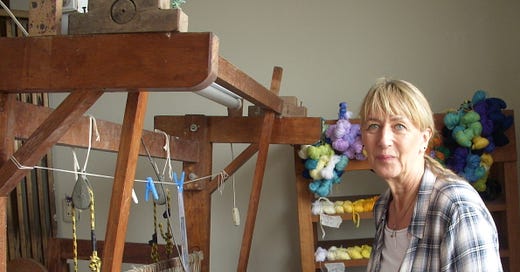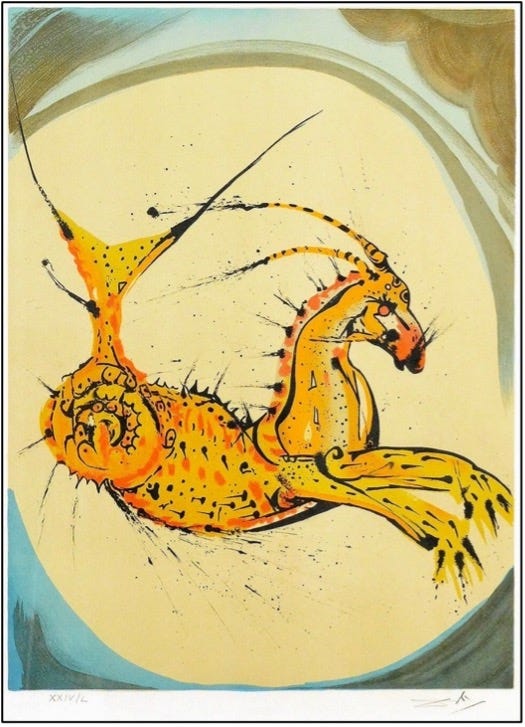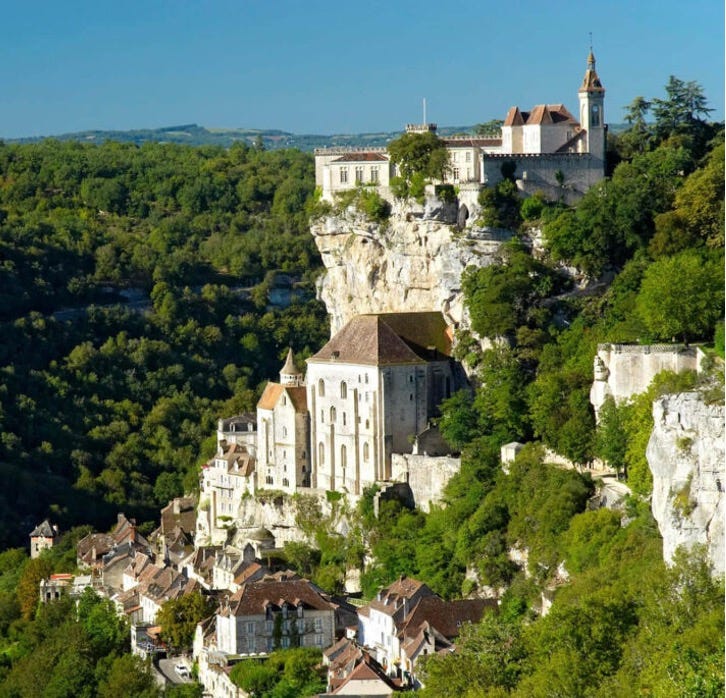Capricorns Are Not Capricious
The art of execution near the top of Lake Avenue, Altadena. Francis Poulenc
When the LA fires broke out, the writing of this Substack was well along. I was juggling the lives of Francis Poulenc—the unlikeliest Capricorn composer; Elvis—the most over-the-top Capricorn performer; and dancer/inventor/influencer/Impresaria Loïe Fuller, a truly ingenious Capricorn and the subject of a yet-to-be released documentary Obsessed with Light. (Btw, the film is a treasure!)
However, on the Sunday of that week 1/12, as I bid farewell to Marilyn Madsen—boarding a flight to Ushuaia, via Buenos Aires, at the tip of Argentina for an 18-day voyage to Antarctica—telling the story of my most remarkable Capricorn friend seemed more time-sensitive to share than the lives of these very consequential historic figures. Near the top of Lake Avenue, Altadena’s vertiginous main drag, that vehement tempest burned to the ground Marilyn’s home, her two workrooms, and a uniquely valuable archive on the first day. This is a story of literal grace under fire—a story of gale-force catastrophe answered by shining providence granted to a person of life-long dedication to service and excellence.
Poulenc did make the cut because this is AstroMusic after all, and I have beautiful music excerpts to share.
High Definition
Anyone who has watched the documentary Planet Earth knows how nimbly and sure-footed mountain goats can scale steep escarpments and leap from pinnacle to peak. Camera edit: close-up of a hoof hammering down, a soft whirl of air and dust rises; pan up to the goat’s intent gaze fixed on some undecipherable point in the distance that is key to this effortless performance—accurate force, minimal displacement, and three-dimensional guidance from acute proprioception.
For modern astrology Capricorn is such a goat. The sea-goat iconography of ancient astrology, however, is more nuanced and puzzling. Unlike the Sagittarius centaur that can gallop and shoot, how can a fishtail make any sense growing out of the chest of a goat?
The actual Zodiac glyph is made up of an officious check mark with a lyrical loop and a sensuous curl. Andrea Richard of Taschen’s Library of Esoterica writes “Ruled by Saturn, the planet of time and restriction, Capricorns know there are limits to our time together and respect its finality. Because of that, they get things done. Capricorn is like the sea goat, an interesting mix of water and land, sensuality and practicality, innovation, and tradition.” With the physical contradictions of a chimera, this cardinal sign is dedicated to upholding certain structures and systems by whatever means available—and necessary.
If you recall December’s explanation of modalities and elements in Ode to—Joy of the Stars’ Blood!, Capricorn, the cardinal earth sign, prefers to engage with people at a practical level.
Destiny
When I met Marilyn in 1979 at the NBC Burbank studio, I was having some success passing myself off as a special-ability milliner, with neither training in hat-making nor advanced costume construction. Several years before then, I learned from the elderly proprietor of a millinery supply company—three flights up in a dark, dusty, and decrepit commercial building in Downtown LA, “If you want to find a good milliner, go to the graveyard!” This was a well-practiced line related with weary bitterness. So, at NBC, I filled a vacancy left by one of these rare-as-hen’s-teeth milliners, Marilyn’s friend, who was pursuing greener pastures.
Marilyn is a six-foot tall Dane, with pale blue eyes, long honey-blond hair, and the complexion of a Dutch painting. Garbed in the white coat of a first-tier cutter/fitter, her affect was serious, deliberate, calm, and without affectation. She seemed slow but was actually in constant productive motion. Her job was to execute the vision of the designer no matter how vague, or indeterminate the drawing and verbal instructions. Whether making flat patterns by some arcane, if well-studied system, or draping muslin on a dress form to mimic delicate chiffon or obdurate leather, remarkable garments were made manifest by her and a bank of “stitchers” who received jobs from Marilyn’s muslin-covered table. It all seemed miraculous to me.
When Marilyn entered the chamber of mirrors that was the NBC fitting room, the star, celebrity, or actor-singer-dancer was usually already there via a separate entrance. Since she towered over even some of the men, Marilyn usually knelt down with deference and seeming humility, a box of large safety pins at hand, while radiating no-nonsense professionalism and competence. In her presence personalities rarely indulged in temperament, attitude, and histrionics. Garments always fit with minor adjustments, sometimes using ingenious tricks-of-the trade to conceal anomalies, asymmetries, and unwanted “fullness”. She was there to serve the talent and make them look as good as possible. Designers were grateful because she served their vision and made them look as good as possible.
Marilyn was an NBC fixture, while I was hired on an as-needed basis. When the word got out, however, that there was a real milliner and special-ability craftsman in the NBC workroom, I was increasingly needed for jobs that confound the imagination—a Polar bear paw for Lucile Ball to match the real thing, a gangster fedora for Kermit the Frog in a Bob Hope Show sketch, five stunt double duplicates of the Village People Indian Felipe Rose’s fake war bonnet for a campy movie, aigrette’s of contraband egret feathers for Aretha Franklin, Johnny Carson in front of the Tonight Show curtain as the sun! The work was never dull or routine. I learned quasi-couture production stitching when big Vegas shows came in and the workroom became all-hands-on-deck. Eventually Lee Smith, the designer for the soap opera Days of Our Lives, saw our utility as a team, and had Marilyn and me assigned to NBC’s Gower Studios, thus giving him extraordinary creative latitude.
Wedding—go for broke!
After Princess Diana’s epic “wedding of the century” was splashed across the television, gone were the baby’s breath wreaths, Victorian voile dresses, and bare-feet-on-the-beach weddings. Days of Our Lives used every publicity strategy available, including outright fiction, to promote the soap opera “wedding of the century.” It fell to Marilyn and me to live up to the studio’s hype. But, seeing my work on the cover of Soap Opera Digest in the supermarket check-out was the end of the line for me. I wasn’t allowed into the photo shoot for Christian Alfonzo’s headpiece and the stylist miscalculated the fit. Maybe nobody else thought she looked silly, but the stylist’s nonchalance, incompetence, or unconsciousness, was a gesture to me of indifference toward an extraordinary amount of work—and its excellence. Furthermore, it was astonishing to me that I cared. I took a job in the non-profit sector doing education reform for cadres of high school humanities teachers. I wasn’t qualified for that job either!
Marilyn branched out. After Star Trek: First Generation, responsible for Patrick Stewart and the show’s special guests, she took on Ally McBeal, responsible for Callista Flockhart. She did the specialty wardrobe for Whitney Houston in The Bodyguard. Loyal clients included Nell Carter, Natalie Cole, Melanie Griffith with Antonio Banderas, and Anne Bancroft. Responsibility for Jennifer Lawrence and Elizabeth Banks in the Hunger Games trilogy led to a long-term relationship with Marvel Studios and responsibility for a majority of the superheroes in all of their franchises. Marilyn’s final Marvel garment, the 2024 crow-inspired long coat for Agatha All-Along star Kathryn Hahn, became an internet sensation with its cleverly concealed stacked back pleats, custom embroidered lining, and exclusive crow-inspired details. Knock-offs for the 2024 winter wear market proliferated. Hallmark sold a Christmas tree ornament of Agatha wearing the coat.
Marilyn Madsen retired a year ago.
Diversity, Equity and Inclusion
Marvel was a relentless task master often requiring twelve-hour days with a 70-mile roundtrip commute from Altadena to Canoga Park. A production hiatus would come with uncertainty about when the next film assignment would start. During these years, Marilyn scheduled trips to study with master weavers. For three weeks in 2018, she lived with the National Living Treasure of Peru Maximo Laura, and his family, to learn his special yarn blending weaving technique. She produced nearly eleven square feet from the loom. While taking a week in Ventura, she learned to grind cochineal parasites and dye wool in shades of red from Porfirio Gutierrez, a Zapotec artist from Oaxaca. The Ornelas sisters, master weavers in the Navajo “Two Grey Hills” style, guided her to make three small Navajo rugs of her own design. Such evidence of excellence in multiple traditions was lost in the fire, along with a meticulously documented slice of Hollywood history.
Marilyn kept her original patterns for all the significant gowns and costumes with fabric swatches and beading samples since 1978. Custom-made fabric remnants shared space with autographed photos and candid scenes from locations including Vancouver, Atlanta, New Orleans, Winnipeg, Richmond, Winston Salem, Red Lodge, Albuquerque, Cincinnati, Savanah, St. Thomas & St. John Virgin Islands, as well Johannesburg in South Africa with Dustin Hoffman. Last year, Marilyn and an assistant took four months to document and organize the archive of her life’s work. Each film had its own sealed bin containing script, rewrites, call sheets, drawings, polaroids of fittings, and location ephemera. On some films, when there were doubles made for stunts, as in the case of a collar for Whitney Houston in The Bodyguard, the production would donate one for her archive.
Marilyn’s library contained over 1600 books on the history of fashion, costume construction, and every available book on knitting, crochet, weaving, embroidery, and beading. Her massive cutting table with its legs extended and wide enough for any bolt of fabric was a gift of Lucille Ball in 1978.
Hard Perimeter
Last week when Marilyn landed in Buenos Aires to catch up with her favorite travelling buddies, the celebrity knitters Arne Nerjordet and Carlos Zachrison, she had settled multiple issues with her insurance company.
While sympathetic and understanding they wanted her to shoot the ruins of her home, weaving studio, workroom, and archive. An extremely stressed but kind California Highway Patrol captain barred her way saying the streets were too hot and would burn her tires. Undaunted, she tried a back way to the foothills. Soon she was stopped by a tank surrounded by the National Guard. Hearing her story, the presiding officer said, “Tell your insurance company that there is a hard perimeter around your house and they will back off.” They did.
Within three days senior staff at Universal’s wardrobe department pulled a complete set of traveling clothes including shoes without Marilyn giving her a single measurement. It all fit. A veteran television costumer offered her a vacant house near the airport. A loyal assistant set up a Go Fund Me page and enough housing offers were made for her to be a nomad as long as she wanted. Dog sitting in the high desert with a swimming pool and balcony view was a destination already set in her February plans.
Leaping back and forth from pinnacle to peak for 45 years, this industrious Capricorn got things done. Her rich hoard of evidence encompassed the last golden age of Hollywood costume construction never to return is gone. But Marilyn’s miraculous blend of water and earth, sensuality and realism, new ideas, and tradition can still be seen everywhere—online, in living rooms, and movie theaters. It would seem that the acronym GOAT—greatest of all time—suits my dear friend.
Francis Poulenc
As a teenager Francis Poulenc overcame his feelings of ugliness by being bright, and fun to be around. He played cards and could compose amusing and agreeable songs. His sometimes impudent and always fearless persona was well-suited to Parisian society, and his music gained success during the Années folles (Crazy Years aka Roaring Twenties). But, as the Second World War approached, an unfamiliar seriousness began changing the character of his music. Diverting banality crafted to a fare-thee-well would give way to striking vistas, bracing contrasts, and flashes of spiritual insight.
Overcoming Odds
Poulenc was born in Paris January 7, 1899, to a pianist mother who died in 1915. Soon after in a Paris bookstore the teenager met France’s leading avant-garde poets, who became lifelong friends and sometime collaborators. In short order, our fearless Capricorn gained considerable notice with his first publicly performed work at age seventeen. Rhapsodie Nègre was promoted by and dedicated to no less that Eric Satie. A twelve-minute work for flute, clarinet, string quartet, baritone, and piano, Poulenc’s text was a dubious mix of supposed Liberian (or was it Hawaiian?) and Parisian slang from the street. The baritone, who was to intone the middle movement’s nonsense syllables and join the ensemble for the finale, was too embarrassed so he forced Poulenc to jump onto the platform and take his place. In the audience were Ravel and Stravinsky! Poulenc’s father died In 1917 leaving behind a well-established family business that manufactured photographic chemicals, and an older sister.
Poulenc served in the army at the front for four months in 1918. The U.S. Army’s all-Black soldier band, The Harlem Hellfighters—led by Ragtime pioneer and pianist James P. Johnson—fought in the trenches of France and entertained the troops. At the end of the war in 1918 the band’s syncopated performance of La Marseilles shocked and delighted a French crowd gathered in the Port of Brest. Coming of age together was the jazz scene in Paris, Picasso’s African mask-Inspired cubist style of painting, and an ambitious young French composer.
Poulenc’s service continued after the war as a typist in the newly formed Ministry of Aviation until 1921. This work hardly deterred the enterprising composer whose rise to international prominence was set when dubbed a member of Les Six after a concert of music by Satie’s circle: Darius Milhaud, Arthur Honegger, Germaine Tailleferre, Georges Auric, and Louis Durey. The name came not from any real common musical ground but from a newspaper headline—and it stuck. The attitude of Les Six suited the times and made Poulenc very busy.
Gathering Storm
How did his majestic organ concerto, finished in 1938, become so expressive of the gathering storm, while radiating an aura both spiritual and secular? Though this work wasn’t the specific turning point for Poulenc, deeply personal reasons brought on a reckoning with mortality and generated the only organ concerto currently in the standard symphonic repertoire.
A spectacularly grotesque car accident beheaded Pierre-Octave Ferroud in 1936. Rumor persisted that he was Poulenc’s friend, or perhaps one of several male paramours. Ferroud was in fact a rival composer spurned by Poulenc’s wide social circle. Poulenc heard of the tragedy while on holiday near Rocamadour, the shrine where a statue of the Black Virgin is venerated. He wrote:
“A few days earlier I'd just heard of the tragic death of my colleague ... As I meditated on the fragility of our human frame, I was drawn once more to the life of the spirit. Rocamadour had the effect of restoring me to the faith of my childhood. This sanctuary, undoubtedly the oldest in France ... had everything to captivate me... The same evening of this visit to Rocamadour, I began my Litanies à la Vierge noire for female voices and organ. In that work I tried to get across the atmosphere of "peasant devotion" that had struck me so forcibly in that lofty chapel”
The 9-minute work’s mix of stringent dissonances and serenely flowing harmonies gave Poulenc access to that mythical beast represented by a fishtail growing out of a goat’s chest—to a deeply personal blending of water and land, sensuality and practicality, innovation, and tradition. Without mentioning the trauma of being orphaned as a teenager and his near simultaneous entrance into a worldly cultural scene, Poulenc recognizes a newfound access to his innate blend of innocence, wonder and purpose.
His large scale choral works followed culminating with the unaccompanied masterpiece Figure Humaine for double mixed chorus of twelve. A setting resistance poems by Paul Éluard and composed under duress during the Nazi occupation of Paris, the score was smuggled to London for its 1945 premiere. the cantata expresses the "suffering of the people of France" waiting in hopeful silence for "triumph of freedom over tyranny." Dialogues of the Carmelites, a durable mainstay in major opera houses since 1957 and Poulenc’s crowning achievement, was based on a popular play. It depicts the political tribulations and eventual decapitation of an order of sixteen nuns at the end of the 1794 Reign of Terror.
Attention to Apprehension
While Poulenc had recommitted to the Roman Catholic faith, he was settled for life with Louis Gautier, a former soldier, despite the church’s opposition to homosexuality. Critic/writer/friend Alan Rich maintained that Poulenc's apprehension for post-World War II France, as it endured a long reconciliation with issues related to the Holocaust, the German occupation and French Resistance, was the opera’s subtext.
The Concerto for Organ, Tympani, and Strings in g minor lasting about 23 continuous minutes has seven seamless sections each with a different tempo. Its compact drama, ravishing colors and textures, and a lively sense of purpose have made the concerto popular with orchestras able to incorporate its demanding organ part. Untrained in organ technique like most French composers, Poulenc was coached by the great organist/composer Maurice Duruflé after extensive study of the Bach organ literature. Duruflé gave the premiere under the baton of Nadia Boulanger.
The two excepts below join together the thematically connected opening and closing passages that alternate austere drama with the tenderness of a brief cello solo performed by Trevor Handy. What remains for you to discover is the central journey where the mercurial blur of cancan and other lively dance rhythms keeps the listener arrested with dramatic shifts of mood and temperature.
This performance, September 21, 2019, inaugurated the new organ console and repositioned organ pipes at the First Presbyterian Church of Santa Monica. Mark Alan Hilt conducts the Jacaranda Strings with timpani performed by Brian Cannady, and organ soloist Thomas Mellan.







